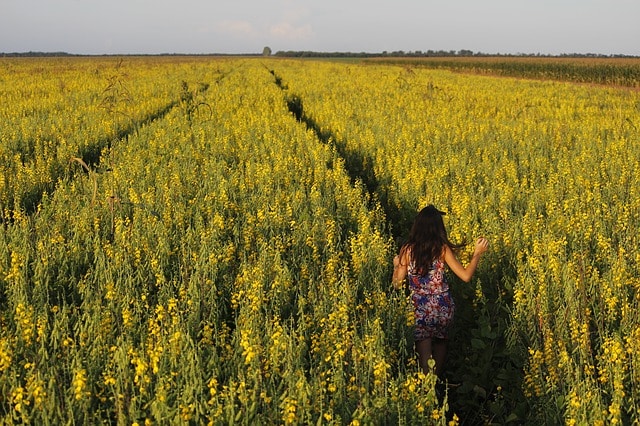The Rattlebox plant, scientific name – Crotalaria retusa is an ornamental plant that’s also medicinal.
While many don’t know it as Crotalaria retusa, its common names are rattleweed, showy rattlebox, cat’s bell, etc.
The reason its name is likened to noise is that the plant produces seeds in pods which makes noise when they become dried.
The stem and leaves of the rattlebox are edible, especially to the Asian people, and also here in America.
Crotalaria retusa Properties
Crotalaria retusa is a slightly hairy shrub that grows to a height of about 1.2m.
The leaves of Rattlebox are simple and fleshy with a very short petiole.
Rattlebox Flower Structure
Crotalaria flowers are borne in clusters at the terminal end of a branch. Each flower has a short pedicel.
The flower is complete and zygomorphic.
There are five green sepals that are fused together at their base to form a cup-like calyx which is slightly hairy.
The corolla is composed of five petals of different shapes and sizes.
The outermost one, which is yellow with purple markings inside is known as the standard petal.
It is the largest and most conspicuous of all the petals.
On the inner side of this petal are two wing petals.
The color of the wing petals is similar to that of the standard petal, however, they are very much smaller in size.
Facing the standard petal are two smaller petals that have fused along one edge to form a boat-shaped structure called the keel.
The base of the wing petal is linked to the base of the keel.
The anterior of the keel is rolled to form a tube with a narrow opening at its tip.
In the bud, the keel is enclosed by the wing petals, and these in turn by the standard petal. then bud is protected by the calyx.
Enclosed within the keel are the stamens and the pistil.
There are ten stamens – Five faces the sepals and five faces the petals.
They are called antesepalous stamens and antepetalous stamens respectively.
The antesepalous stamens have short filaments and elongated anthers.
The antepetalous stamens, on the other hand, have a long filament and rounded anthers.
The lower halves of these ten filaments fuse to form a sheath round the ovary; the upper halves bend upwards.
The pistil consists of an elongated, pod-shaped ovary, an upturned style, and a stigma.
The portion of the style and a stigma is hairy.
The ovary is superior and has a carpel with many ovules arranged along its margin.
This sort of placentation is said to be marginal.
The flower of Crotalaria is protandrous and entomophilous.
Rattlebox Pollination
Bees visit the flowers of the Crotalaria in the morning.
These bees are attracted to the flowers by their bright colors and the nectar present in them.
The bees accumulate at the base of the keel of each flower, and only insects like the bees, which have long, sucking mouthparts, can reach it.
Sometimes, butterflies visit the flower but they are not a good pollinating agent.
When a showy rattlebox flower is in full bloom, a bee flitters around it and is guided by the markings inside the standard petal towards the nectar.
As the bee alights on the wing petals, its fairly heavy body weight causes the wing petals to depress.
Since the base of the wing petals is linked to the keel, the latter is also forced down.
The antepetalous stamens mature before the antepetalous stamens and shed their pollen into the tube formed by the keel.
By this time the antepetalous stamens are mature and their filaments have grown longer than those of the antesepalous stamens.
They lie above the withered antesepalous stamens and tightly close the base of the tube formed by the keel.
Since the rounded anthers produce very little pollen, their main function is to push pollen out of the keel.
When the keel is forced further down by the bee, the rounded anthers of the antepetalous stamens push a ribbon of pollen out of the keel through the narrow opening onto the hairy undersurface of the bee.
As the bee tries to reach the nectar, the pressure increases and this enables the stigma to emerge from the narrow opening.
The stigma is not mature at this stage; therefore, self-pollination is not likely to occur.
The bee with its load of pollen then crawls out and flies to another flower.
The keel returns to its original position to enclose the stigma.
When the bee visits another flower with a mature stigma, its pollen-dusted body will brush against the stigma, hence, cross-pollination occurs.








